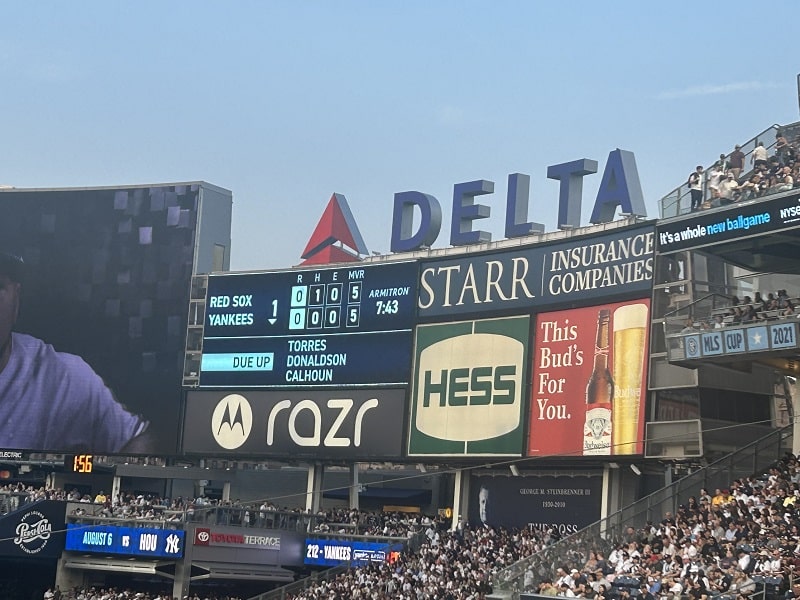Last updated on December 20th, 2023 at 04:59 pm
MVR is an abbreviation that stands for mound visits remaining during an MLB game. MLB continues looking for ways to speed up the pace of play of action, and one way to do that is to limit stoppage during a game. As of 2018, each baseball team only can have five mound visits during a nine-inning game. If a game goes into extra innings, each team receives one more additional visit to the mound.
What is MVR in Baseball
MVR in baseball stands for mound visits remaining. During baseball games, you will see a counter showing how many mound visits are left in the game. For example, if each team has 5, that means they only can use 5 mound visits during the entire 9 innings of play. If a coach forgets how many mound visits they have in the game, they will receive an ejection from the umpire if they go out to the mound to talk to the pitcher. The idea behind MVR is to help speed up the game to reduce breaks in the action. You can learn more about this on this article: https://thestadiumreviews.com/blogs/info/what-is-mvr-in-baseball/
What is a Mound Visit in Baseball?
A mound visit in baseball stops play’s action to meet with the pitcher to go over various strategies. A typical mound visit is with the pitching coach or baseball manager, the pitcher, the catcher, and sometimes the infield team. During a mound visit, players will discuss how to pitch to a hitter, how the pitcher feels on the mound, if a pitching change needs to occur, and more. Mound visits should take 30 seconds or less, and if they exceed, an umpire will arrive to break up the meeting.
What Counts as an MVR in Baseball?
There are a few ways that MLB counts a mound visit during a game. For example, let’s assume that the Tampa Bay Rays are playing the New York Yankees. During the game, the Tampa Bay Rays coach comes out of the dugout to meet with a pitcher to go over strategy. That counts as one mound visit against the Tampa Bay Rays.
Another example is if the New York Yankees shortstop jogs out to the mound to visit the pitcher. The meeting can be if the pitcher seems rattled after giving up a home run or if the pitcher is a rookie and the veteran wants to check in to calm them down. Regardless of what happens or how long during that meeting, that counts as one mound meeting for the Yankees.
Finally, a coach coming out of the dugout to meet with a pitcher counts as a mound visit.
What are the Exceptions?
Like any rule change in baseball, there are exceptions to the five mound visits. One example is if the pitcher appears to suffer an injury when pitching, and the coach and trainer need to check on them. If the coach and or trainer deem the pitcher should be taken out (or stay), this won’t count against the MVR count.
Another exception to the rule is if the catcher and pitcher become crossed up when a ball arrives at home plate from the pitcher. With the fear of baseball teams stealing signs during a baseball game, catchers and pitchers have complex signals and sequences to communicate what pitch is coming. If a clear cross-up happens where the catcher may think a curveball is coming, but a fastball surprises them, the umpire will allow the two players to meet without MVR counting.
One more exception is if a pinch hitter replaces a current player’s at-bat, a catcher can quickly meet with the pitcher if they choose. Another one-off example of a “mound visit” is if an infielder visits the mound to clean their spikes off via the rubber scrapper. While both of these exemptions are rare, fans and players should recognize that these brief visits don’t count as an MVR.
Could Players Meet During a Suspension of Play?
Any suspension of play can result in an unaccounted mound visit. For example, a fan can run on the field and disrupt the action of the sport. While security comes on the field to get the fan, players can meet on the pitching mound, and it won’t count against the MVR.
What Happens if a Player or Coach Tries and Visit after the 5 Meeting?
If a coach comes out to the mound to talk to the pitcher and is exceed their allocated mound visits, they will need to take that pitcher out of the game. If the pitcher has not faced a minimum of three batters, then they will be taken off the mound after completing that.
A suspension can occur if a player and or coach try and meet with a pitcher after exceeding their five mound visits. Generally speaking, umpires are the ones to make the call if a suspension needs to take place. You can read more about the violations in the MLB rules to see what the official langue states.
Conclusion: What is MVR in Baseball?
In summary, MVR expands upon a traditional mound visit that occurs during a baseball game. There is a limit to only having five meetings at the mount. That means that teams must be strategic when they use them. The concept behind this change is to speed up the play during a game.
Similar Posts
What Does a Baseball Manager Do?
What Does QAB Mean in Baseball?
What Does OPS Mean in Baseball?
What Does a GM Do in Baseball?
Greg Kristan, owner of The Stadium Reviews, LLC and TM Blast, LLC, brings his extensive experience visiting over half of the MLB ballparks, along with numerous MLS, NHL, NBA, and NFL venues, to provide in-depth coverage on the bag policy, food options, and parking. He has also been interviewed about his experiences on several sports podcasts.







